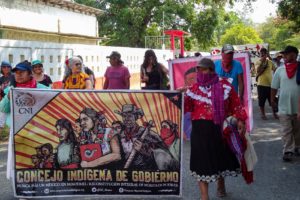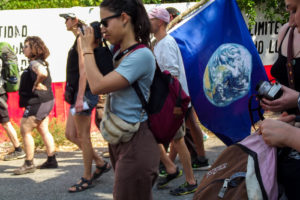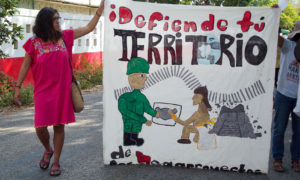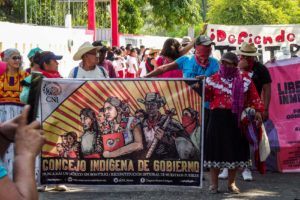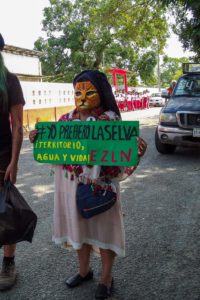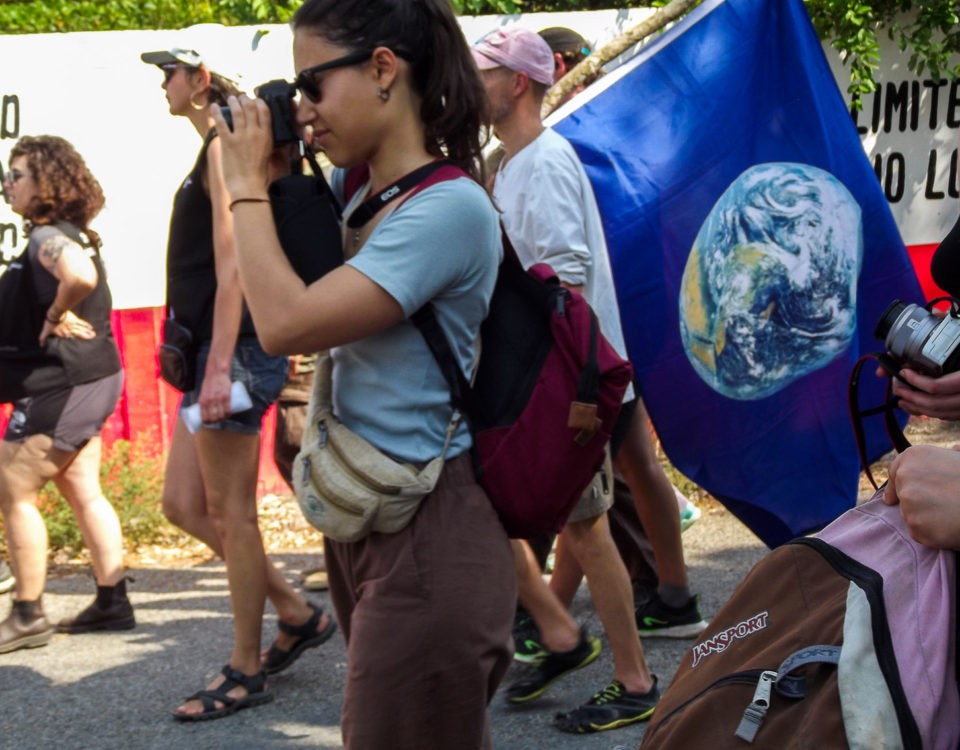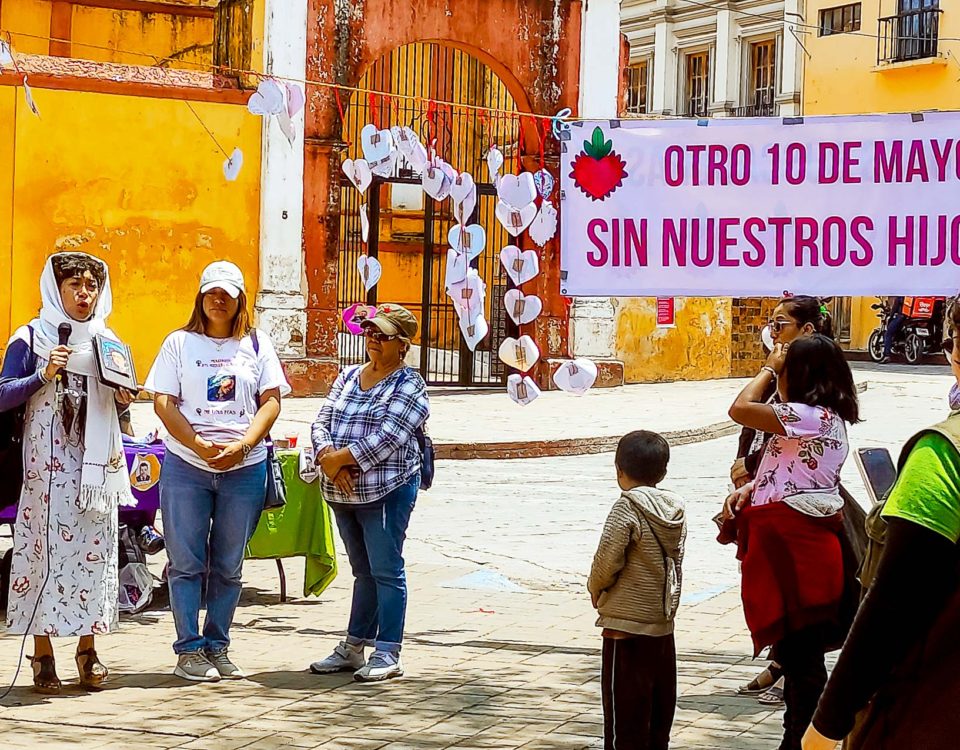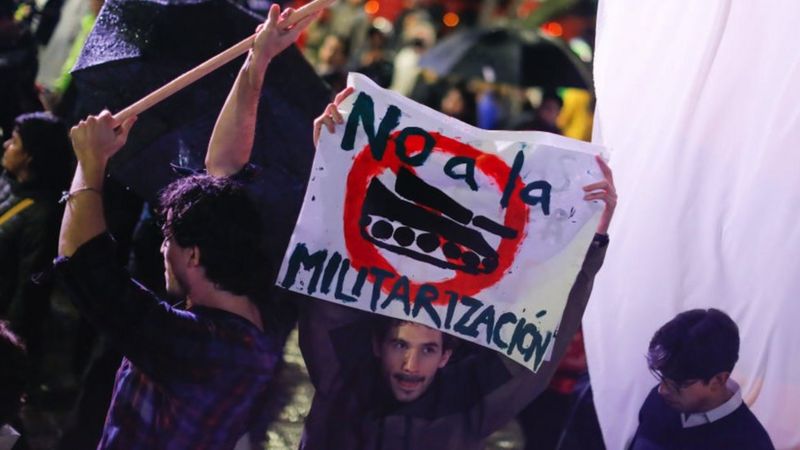
LATEST: Concern over Ongoing Militarization in Mexico
17/06/2023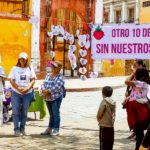
ARTICLE: Disappearance – indelible trace of absence, tireless search. Seed of struggle, brotherhood and memory
17/06/2023“The South resists, it exists because it resists”
“The Isthmus is not for sale, it is loved and defended”
With the megaprojects of the Maya Train, and the Transisthmic Corridor and the Morelos Integral Project, which have been managed as separate projects, today we openly know that they are connected to an even larger project that encompasses several foreign countries, not only Mexico, for the imposition of the aforementioned they have put them at the disposition of the more intensified and violent armed forces, in this case the Navy, the Army, the National Guard, the paramilitaries, local and state police, and organized crime, as if that were not enough, they have legalized the territorial dispossession with the armed forces, justifying that they are of national security and public utility.
E l Sur Resiste (The South Resists) is a movement that unites different organizations and people from the southern and southeastern states of Mexico (mainly from the National Indigenous Congress – CNI), who fight against megaprojects. Between April 25th and May 4th, 2023, a Caravan convened by this movement toured the states of Oaxaca, Veracruz, Tabasco, Campeche, Yucatan, Quintana Roo and Chiapas, documenting the effects of megaprojects in the territories, such as the Transisthmic Corridor and the Maya Train, and ending with an International Encounter in San Cristobal de Las Casas, Chiapas.
Oaxaca: Resistance in the Tehuantepec Isthmus
On the night of April 25th, the Caravan arrived at Puente Madera, a place that has been known for the fight against the installation of an industrial park that is part of the Interoceanic Corridor project. For this reason, it has witnessed multiple sit-ins and blockades. Seeking to be heard, people from the community welcomed the caravan with torches and applause. “The Isthmus is not for sale, it is loved and defended”, they shouted.
El Pitayal
In this place, the communities have resisted against the installation of one of the seven industrial parks that the federal government is trying to build with the same logic. There are more than 350 hectares that are intended to be used in the construction of this work. Through the National Institute of Indigenous Peoples, the 4T government has carried out consultation processes that, denounced by the communities, are not “real”, since they have resorted to forging signatures and direct threats against those who oppose this project.
“On this mountain there is a biodiversity of flora and fauna, for them this space is unproductive land, but for us it means a lot, for many years it has given us sustenance, as indigenous communities, for example, the mezquite is a tree that provides the firewood to prepare the products that we eat and sell and the famous tortilla chips from Puente Madera and San Blas Atempa. Deer, wild horses, iguanas, and coyotes live in this place”, said one of the community leaders during a thanksgiving ceremony held in El Pitayal. For the communities in this area, the territory goes beyond the physical space, it implies the social, the community, the history they have lived and is considered something sacred for the Zapotec peoples who inhabit it. By destroying places like El Pitayal, irreparable damage is being done to the community, affecting their way of living and coexisting with nature. This is an aspect that has been ignored by the Mexican government, denounced the inhabitants of the area.
From El Pitayal, resistance work has also been carried out against the wind farms that have been built in Oaxaca. However, and as they have reported on more than one occasion, one of the government responses to the actions of the peoples has been the persecution and criminalization of human rights defenders. As a result, there are currently 17 arrest warrants against members of the Assembly of the Peoples of the Isthmus in Defense of Land and Territory (APIIDTT). On January 17th, 2023, David Hernandez Salazar, one of their leaders in Puente Madera, was detained by the authorities for eight hours. Finally, he was released due to pressure exerted by different communities and human rights organizations in and outside the country.
“It is a lie that they want progress for the indigenous communities, they only seek their economic profits, but we will continue fighting for our lands and for life”, APIIDTT members nevertheless affirmed.
Mogoñe Viejo: Land and Freedom Sit-in
At the time of the arrival of the Caravan, the sit-in had lasted 60 days blocking the renewal of the Transisthmic Train tracks. 32 organized communities that are part of the Union of Indigenous Communities of the North Zone of the Isthmus (UCIZONI) decided in this way to express their rejection of this megaproject. They reported that they are observed daily by personnel from the Navy and the National Guard, who have repeatedly threatened to evict the camp.
“We know that the Oaxaca government has said that if we don’t leave, they are going to evict us. How dare they say this? They are the outsiders and we are the owners of this land. Our ancestors defended this land, that’s why it exists, so how are they going to evict us from our land?”, they asked.
UCIZONI, for its part, has denounced that this project intends to build roads, gas pipelines, oil pipelines, refineries, factories, mines and ten industrial parks, which implies dispossession and displacement of many communities in the area. “From June 2019 to March 2023, we have counted around 69 mobilizations of peoples to prevent work from advancing and damage to these projects. On February 3rd, 2023, three communities were mobilized together: Palomares, Mogoñe Viejo, and Sarabia. The Mexican Navy was present at the three mobilizations trying to intimidate. This is the 4T response to our demands.”
The day after the Caravan passed through this point, the camp was evicted by members of the Navy and the police, who detained six Mixe indigenous people who were later released. The Caravan, which was in Veracruz at the time of the events, blocked the federal highway belonging to the municipality of Oteapan for more than an hour, in rejection of the eviction.
Veracruz
Oteapan, Acayucan
This community denounced that, since 2022, the Government has tried to remove seven neighborhoods: La Dina, Tierra Colorada, Tapalan, Porvenir, Rancho Alegre, Predio Viveros, and El Naranjal; These lands are located in the place where the tracks of the Transisthmic Train that connects with Oaxaca intend to pass.
Since 2013, in the municipality of Jaltipan next to Oteapan, an open-air coke dump has been installed. This place receives oil refining waste from the General Lazaro Cardenas Pemex plant in Minatitlan, Veracruz. The communities have denounced the impact it has on the environment and human health, but so far, no State agency has responded. They have held sit-ins demanding that the federal government allow them to live freely in their territories and not continue to destroy the social fabric of their communities.
Tabasco
Colonia El Bosque, disappearing due to global warming
In this community you can see how the sea has gradually destroyed houses, the kindergarten, what was once the pier, all due to climate change. The residents fear for their lives and the future of their families, who have historically lived from fishing. In Mexico, this is one of the first known cases of displacement for this reason. The destruction of this colony also puts an end to years of folklore, of social fabric, of community practices that have allowed them to maintain themselves over time.
The residents observe the ruins nostalgically and remember their neighbors who have been displaced to survive. They demand that the federal government help them relocate because they don’t think they can stay much longer in this place. Since February 2023, SEMARNAT has been in contact with the community to start the relocation process, although it is not yet known how long the process may take, nor the place to which the residents will be transferred.
The case of the Forest is a wake-up call at the national level on the public policies that the states are producing against the reality of climate change. It is a global concern that governments do not have among their priorities the attention to this phenomenon that is increasing more and more.
Candelaria, Campeche
One of the Maya Train stations will be located here. The construction of the new roads is already well advanced. The Caravan listened to testimonies that pointed out different effects: more than 300 houses have been evicted and those who resisted selling their land were threatened or forced to accept the money they were offered. They also claim that stomach infections and respiratory difficulties have increased due to constant exposure to construction materials and water pollution. Other communities denounce that the project has brought division: on the one hand, there are those who support the construction of the train for the supposed economic benefits that it will bring; and, on the other hand, there are those who oppose it because of the irreparable damage it is causing at an environmental and social level.
The Candelaria River, which has given life to the communities through which it passes, is disappearing due to the materials that are part of the construction of the train. The Caravan was able to observe how one side of the river looks immense, surrounded by trees, while the other has been largely filled in and currently there are only ten meters left for the water to circulate. The communities denounce that they were not consulted about the works that involved the river, and this constitutes a violation of Mexican laws, including the self-determination of native peoples.
Xpujil, Campeche
The jungle in this state is being illegally devastated by the Maya Train, denounced the communities of this area that for the same reason have filed injunctions and legal recourses to stop the construction of the section in their territory. Legally, only investigative tasks should be carried out, because in 2019 the temporary suspension of the work was achieved, a decision that was later ratified by the Collegiate Court, granting the definitive suspension. Despite this, the Mexican Army has begun construction of a hotel in the middle of the jungle and the tracks for the train to pass through. “The indifference of the different government bodies to the demands of the communities is evident”, said a community leader.
Valladolid, Yucatan
Jungle yes, train no! Water yes, train No! Cenotes are not for sale; they are loved defended! That train is not Maya, that train is military! The participants of the Caravan shouted during their passage through Valladolid. A representative of the Xpujil Calakmul council shared that they currently have an injunction that has stopped construction in that sector, but added that the National Guard and Army are building a hotel that threatens to destroy one of the protected jungles of the American continent. On the other hand, they denounced that more than nine million trees have been felled between Merida and Xpujil for the construction of different tourist attractions.
Quintana Roo
Ejidatarios from the town of Nicolas Bravo, belonging to the municipality of Othon P. Blanco, denounced that Section 7 of the Maya Train is crossing their territory and that they were not consulted about the passage of this work. They spoke about the legal actions that they have carried out, but affirmed that they have not received any response from the three levels of government. One aspect that worries them a lot is the construction of an eco-tourism hotel that is affecting the Maya Jungle and threatens to destroy a sacred territory for the original peoples.
In Cancun and Playa del Carmen, the tourism model that is being promoted by government bodies has greatly increased the rates of violence, problems such as drug trafficking and consumption, forced disappearances, and femicides have been on the rise. The famous development that is being talked about is destroying the social fabric in the communities. The cartel turf wars also puts the lives of the inhabitants of this territory at risk, the communications team of elsurresiste.org affirms in its report.
“That model has been about taking away people’s access to the beach, the territory has been taken over by large tourism capital, what FONATUR wants is to carry out this scheme of large investment by businessmen, and the government is the one that opens the way so that these entrepreneurs can enter. The environment, the organization in defense of the territory, human rights, are an obstacle for this scheme”, affirmed a member of the community.
Chiapas
In El Progreso ejido, Pijijiapan, they have been resisting against high electricity costs for more than 30 years. Its inhabitants assure that, although in Chiapas there are companies that produce energy, for many of them it is a privilege to enjoy this service. “Why do we have to choose between eating, buying clothes or paying a bill that is between 1,500 and 3,000 pesos? We are peasants, workers, fishermen, we don’t have enough money to pay those fees”, said a community leader. The communities demand that the current government fulfill the promises made in the election campaign. They say they feel used, since they have not received a government response to the demands they make.
In Tonala, members of the Oaxacan communities, the Otomi community of Mexico City and other people from Veracruz, rejected the megaprojects that are offering an idea of progress that is convenient for the government and companies, but that in many ways destroys the lives of those who they inhabit the territories where they plan to build. They demand a stop to the environmental massacre that the Mexican South and Southeast are experiencing. The rights of the original peoples are being violated and those who raise their voices in defense of life are intimidated and killed, they affirmed.
Militarization and migration were also very important issues on this tour. In Chiapas, there are currently 147 military camps, which indicates a strategy for territorial control, and the communities experience it as a direct threat to their lives. During the journey between Tonala and Puente Madera, the Caravan was detained at least seven times by personnel from the Mexican Army, the National Guard, the State Police and the National Migration Institute (INM). It was also possible to observe groups of migrants who, upon seeing a checkpoint, decided to run into the bush to avoid being detained.
In Palenque, where according to official reports 80% of the work corresponding to Section 1 of the Maya Train that will reach Escarcega, Campeche, is already completed, the communities stated that they were not consulted about this construction. They demand that the government invest in health and education, they affirm that the real beneficiaries of this project will be great international economic powers, while the local inhabitants will receive misery, dispossession and destruction of the territory they have historically inhabited.
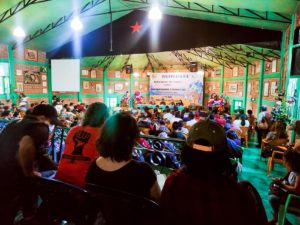
Meeting “World Corporate Capitalism, Planetary Patriarchy, Autonomies in Rebellion”, San Cristóbal de Las Casas, May 2023 © SIPAZ
THE SOUTH RESISTS INTERNATIONAL ENCOUNTER 2023:
World Corporate Capitalism, Planetary Patriarchy, Autonomies in Rebellion
More than 900 people from approximately 30 countries and 33 indigenous peoples of Mexico met at the CIDECI Indigenous Center for Comprehensive Training, located in San Cristobal de Las Casas, to analyze everything encountered during the Caravan, listen to experiences of other countries that have similar struggles and seek networking strategies that strengthen community processes that continue to struggle for life. During the event, letters from different parts of the world were read showing support for the resistance and the original peoples.
In the meeting, some common problems were identified, such as the presence of organized crime in different territories, cooptation of young people and children by crime, division in communities through economic offers or assistance programs, deterioration of lands due to monoculture, fumigations, water pollution and the fact that the water is being destined for large companies and not for communities.
Resistance of the Original Peoples in Defense of Life and Territory
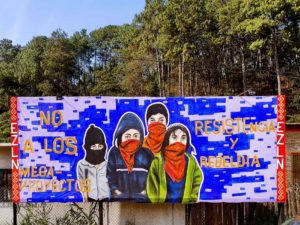
Meeting “World Corporate Capitalism, Planetary Patriarchy, Autonomies in Rebellion”, San Cristóbal de Las Casas, May 2023 © SIPAZ
As a sign of memory and hope, the communities recalled some historical victories that they have had as a result of the organization of the peoples. They mentioned that they have held different meetings to encourage the heart, strengthen the struggles, the recovery of lands and to stop projects through injunctions in different states of the country. They highlighted the struggle of women in all territories and the strengthening of autonomy through support networks between Zapatista Caracoles and organizations that support the Zapatista National Liberation Army (EZLN).
“You have to recognize two lights of current hope; the struggle of women in all its forms, although men are concerned that they break windows and damage monuments, insignificant things in the face of the violence they experience. The other light is the light of the Original Peoples who fight to defend the territory; you have to feed these two lights, make them grow and bring them together”, it was proposed.
During his speech, Raul Zibechi, a Uruguayan writer and activist, who was invited as a speaker, recalled the importance of looking at drug trafficking as a perfect symbol of capital, which represents dispossession through violence. He affirmed that it is very difficult to identify the line between drug trafficking and power because there is an alliance between criminal groups, governments and large companies. He also recognized the growth and multiplication of autonomies in Latin America, which is a victory full of diversity, colors and strategies that permeate each original people from their ancestral knowledge.
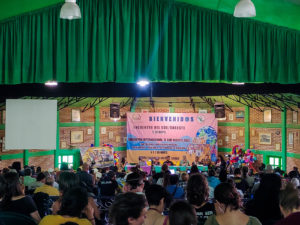
Meeting “World Corporate Capitalism, Planetary Patriarchy, Autonomies in Rebellion”, San Cristóbal de Las Casas, May 2023 © SIPAZ
For her part, Ana Esther Ceceña, a Mexican economist, carried out a geopolitical analysis of what is happening in the Mexican Southeast given the dispute for power between the United States and China, which leaves Mexican territory in the middle due to its geographical characteristics and economic production. This has gone hand in hand with the destruction of ecosystems, the displacement of communities and the appropriation of culture for economic benefits. However, the point was not to get overwhelmed, but to seek strategies to continue defending the territories and cultural practices that must remain. “There is also a strategy of dispossession of everything symbolic, spiritual, cultural; an example is all this destruction of archaeological treasures on the route of these trains, the excavator breaks them, destroys them, and those that they don’t are taken away, they are stolen. All this that is found is history, and it is being destroyed, for the sake of a progress that is actually not”, she concluded.
At the end of the meeting, a statement was read that stated: “The Caravan allowed us to meet the jungle that resists. Where the trees are cut down, life springs up again. We listened to the birds and their messages, we drank the crystalline water from the wells and we breathed the clean air of rurality. We find peoples and communities that organize, resist and do not allow dispossession or even the entry of companies into their territories. They also take measures to recover ways of life that build hopeful autonomies for humanity. On the other hand, we find rebellious cities that build collectivity and autonomy in the midst of urban monsters, where love for the land and territory flourishes again. We affirm loud and clear and from our hearts that fight and organize, that we will continue to meet and join them with other struggles throughout the world. Neither with the National Guard, nor with the Navy, nor with the Army. They will not stop us! While you destroy, we build.”

